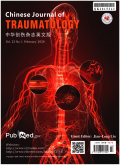- 钛学术文献服务平台 \
- 学术期刊 \
- 医药卫生期刊 \
- 外科学期刊 \
- 中华创伤杂志(英文版)期刊 \
Establishment and validation of a model for brain injury state evaluation and prognosis prediction
Establishment and validation of a model for brain injury state evaluation and prognosis prediction
基本信息来源于合作网站,原文需代理用户跳转至来源网站获取
摘要:
Purpose::Traumatic brain injury (TBI) is one of the leading causes of disability and death in modern times, whose evaluation and prognosis prediction have been one of the most critical issues in TBI management. However, the existed models for the abovementioned purposes were defective to varying degrees. This study aims to establish an ideal brain injury state clinical prediction model (BISCPM).Methods::This study was a retrospective design. The six-month outcomes of patients were selected as the end point event. BISCPM was established by using the split-sample technology, and externally validated via different tests of comparison between the observed and predicted six-month mortality in validating group. TBI patients admitted from July 2006 to June 2012 were recruited and randomly divided into establishing model group and validating model group. Twenty-one scoring indicators were included in BISCPM and divided into three parts, A, B, and C. Part A included movement, pupillary reflex and diameter, CT parameters, and secondary brain insult factors, etc. Part B was age and part C was medical history of the patients. The total score of part A, B and C was final score of BISCPM.Results::Altogether 1156 TBI patients were included with 578 cases in each group. The score of BISCPM from validating group ranged from 2.75 to 31.94, averaging 13.64 ± 5.59. There was not statistical difference between observed and predicted mortality for validating group. The discrimination validation showed that the BISCPM is superior to international mission for prognosis and analysis of clinical trials (IMPACT) lab model.Conclusion::BISCPM is an effective model for state evaluation and prognosis prediction of TBI patients. The use of BISCPM could be of great significance for decision-making in management of TBI.

推荐文章
Test the topographic steady state in an active mountain belt
Taiwan
Uplift
Denudation
River profile
Sediment yield
In-situ 10Be
Evaluation of groundwater quality in the Dibdibba aquifer using hydrogeochemical and isotope techniq
Safwan-Zubair
Dibdibba formation
Geochemical modeling
Mixing
Stable isotopes
Basra
Spatial prediction of landslide susceptibility using GIS-based statistical and machine learning mode
Landslide susceptibility mapping
Statistical model
Machine learning model
Four cases
Lyocell与Model织物风格比较
再生纤维素纤维
Lyocell织物
Model织物
风格特征
内容分析
关键词云
关键词热度
相关文献总数
(/次)
(/年)
文献信息
| 篇名 | Establishment and validation of a model for brain injury state evaluation and prognosis prediction | ||
| 来源期刊 | 中华创伤杂志英文版 | 学科 | |
| 关键词 | Traumatic brain injuries Prognosis International mission for prognosis and analysis of clinical trials | ||
| 年,卷(期) | 2020,(5) | 所属期刊栏目 | Original Article |
| 研究方向 | 页码范围 | 284-289 | |
| 页数 | 6页 | 分类号 | |
| 字数 | 语种 | 中文 | |
| DOI | 10.1016/j.cjtee.2020.08.006 | ||
五维指标
引文网络
引文网络
二级参考文献 (0)
共引文献 (0)
参考文献 (7)
节点文献
引证文献 (0)
同被引文献 (0)
二级引证文献 (0)
1957(1)
- 参考文献(1)
- 二级参考文献(0)
1982(1)
- 参考文献(1)
- 二级参考文献(0)
1984(1)
- 参考文献(1)
- 二级参考文献(0)
1990(1)
- 参考文献(1)
- 二级参考文献(0)
1996(1)
- 参考文献(1)
- 二级参考文献(0)
2006(1)
- 参考文献(1)
- 二级参考文献(0)
2010(1)
- 参考文献(1)
- 二级参考文献(0)
2020(0)
- 参考文献(0)
- 二级参考文献(0)
- 引证文献(0)
- 二级引证文献(0)
研究主题发展历程
节点文献
Traumatic brain injuries
Prognosis
International mission for prognosis and
analysis of clinical trials
研究起点
研究来源
研究分支
研究去脉
引文网络交叉学科
相关学者/机构
期刊影响力
中华创伤杂志(英文版)
主办单位:
中华医学会
出版周期:
双月刊
ISSN:
1008-1275
CN:
50-1115/R
开本:
大16开
出版地:
重庆市渝中区大坪长江支路10号
邮发代号:
78-81
创刊时间:
1998
语种:
eng
出版文献量(篇)
1765
总下载数(次)
0
总被引数(次)
7300
期刊文献
相关文献
推荐文献
- 期刊分类
- 期刊(年)
- 期刊(期)
- 期刊推荐
中华创伤杂志(英文版)2022
中华创伤杂志(英文版)2021
中华创伤杂志(英文版)2020
中华创伤杂志(英文版)2019
中华创伤杂志(英文版)2018
中华创伤杂志(英文版)2017
中华创伤杂志(英文版)2016
中华创伤杂志(英文版)2015
中华创伤杂志(英文版)2014
中华创伤杂志(英文版)2013
中华创伤杂志(英文版)2012
中华创伤杂志(英文版)2011
中华创伤杂志(英文版)2010
中华创伤杂志(英文版)2009
中华创伤杂志(英文版)2008
中华创伤杂志(英文版)2007
中华创伤杂志(英文版)2006
中华创伤杂志(英文版)2005
中华创伤杂志(英文版)2004
中华创伤杂志(英文版)2003
中华创伤杂志(英文版)2002
中华创伤杂志(英文版)2001
中华创伤杂志(英文版)2000
中华创伤杂志(英文版)2020年第6期
中华创伤杂志(英文版)2020年第5期
中华创伤杂志(英文版)2020年第4期
中华创伤杂志(英文版)2020年第3期
中华创伤杂志(英文版)2020年第2期
中华创伤杂志(英文版)2020年第1期

 免费查重
免费查重










